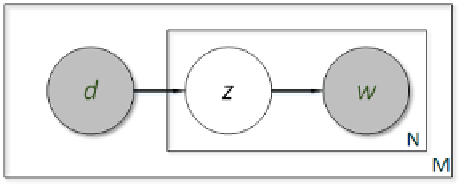Graphics Reference
In-Depth Information
learned from the visual words. Moreover, it has simplicity and low computational
complexity.
Let
Z
= [
z
1
,…,
z
T
] be the set of latent topics between documents
D
= [
d
1
,
d
2
, …,
d
M
]
and words
W
= [
w
1
,
w
2
,…,
w
N
,]. The goal of pLSA is to learn the latent topic proba-
bility distribution through the joint probability distribution of documents
D
and words
W
. Specifically, for image retrieval application,
D
is a dataset of images, and
W
is the
collection of visual word representations in the dataset and
Z
can be viewed as the
latent variables between
W
and
D
, namely the topic-level representation. The graph
model representation of pLSA is shown in Fig. 2.
Fig. 2.
Graph model representation for pLSA
The joint probability between
W
and
D
is defined by Eq. (2):
T
Pd w
(, )
=
Pd Pw d
()(
,
Pw d
(
)
=
Pz d Pw z
(
)(
(2)
i
j
i
j
i
j
i
k
i
j
k
k
=
1
where
P
(
d
i
) denotes the probability which
d
i
occurs,
P
(
z
k
|
d
i
) is probability distribu-
tion of latent topic
z
k
in document
d
i
and
P
(
w
j
|
z
k
)is the probability distribution of topic
z
k
on word
w
j
. pLSA model can be viewed as a maximum log-likelihood formulation:
NM
L
=
n d
(, )log(, )
w
P d
w
i
j
i
j
i
==
11
j
(3)
nd w
(, )
N
M
T
i
j
=
nd
()log()
Pd
+
log
Pw z Pz
( |
)( |
d
)
i
i
j
k
k
i
nd
()
i
=
1
j
=
1
k
=
1
i
where
n
(
d
i
,
w
j
) represents the frequency that word
w
j
occurs in document
d
i
and
n
(
d
i
) denotes the occurrence frequency of
d
i
. Therefore, the solution of pLSA model
is to seek the optimal
P
(
z
k
|
d
i
) and
P
(
w
j
|
z
k
) through expectation-maximization (EM)
algorithm [9], and
P
(
z
|
d
i
) is the topic-level representation of the
i-
th document.
3.2
Low-Rank and Sparse Matrix Decomposition
According to [10], the word-level representation generated by BoW implies both
correlated and specific information, and each of these two parts is more robust and
discriminative for representing the image content. In this paper, we apply the low-
rank and sparse matrix decomposition method to decompose the BoW representation
(
i
.
e
., the word-level representation) of the images into two parts (
i
.
e
., low-rank part
and sparse part). After decomposition, the low-rank part can reveal the correlated




Search WWH ::

Custom Search